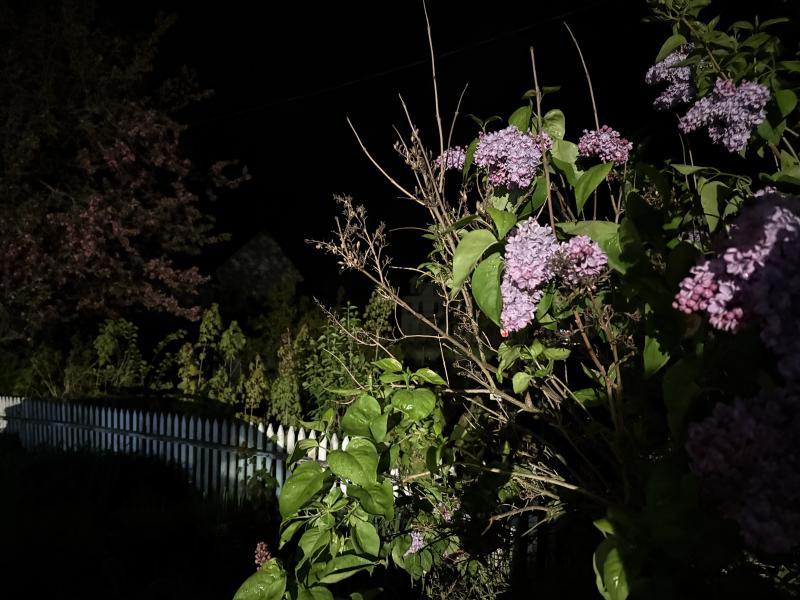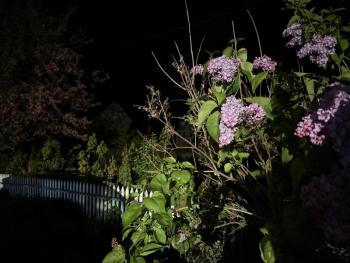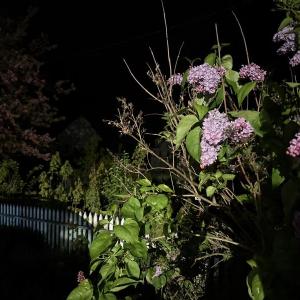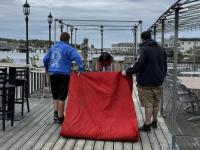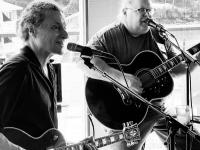A Sea of Birds in the Night Sky
It was eleven o’clock on Sunday night, May 18, here in Maine. The lilac flowers glowed like purple ghosts in the dim light from the porch lamp; near the end of driveway, limbs covered in apple blossoms reached through the darkness to the sky. Occasionally, a car passed through the light beaming down from the telephone pole at the corner.
It was not a moment that many people would associate with bird migration.
Yet above us, unseen, were hundreds, perhaps thousands of birds flying north. We knew because of their high-pitched flight calls pitched down in the dark—short little packets of sound from various directions and heights. Faint “peeps” like the sound of a spring peeper carried from a distance, perhaps many hundreds of feet above or off to the left or right. These were the first Swainson’s thrushes of the spring for us. We could only imagine their tan backs and yellow faces somewhere up there in the dark as they beat their wings to travel through the night. They had been traveling like this for days from their wintering grounds in South America to reach their breeding places here in Maine and northward across Canada and Alaska.
Soon the calls increased—lots of the abrupt, buzzy “drerk” calls of the common yellowthroat and the liquid “tsweet” notes of the American redstart. Short, high-pitched calls most humans would never notice were soon echoing down every few seconds. Hundreds of them as the minutes passed. Warblers mostly, but a few sparrows—Savannah sparrows and white-throats among them.
Experiencing the night migration of birds like this always feels like a mysterious miracle. To know that a sea of birds, tens of millions strong, is moving across the U.S. and Canada on a night like this is difficult to comprehend. Experiencing it acoustically from a single location on a dark night feels both wonderous and almost a little unnerving. Tens of millions of migrant birds move across Earth’s skies each spring and fall while most humans are asleep or inside the house watching tv. It’s one of the grandest, most dramatic biological phenomena on the planet—billions of birds, migrating north to south in spring and back again in fall.
For us here in Maine (or almost anywhere in the US and southern Canda), experiencing this global wonder doesn’t require a long flight to a distant land. Step outside after dark on many a night in May (especially mid-May) and stand quietly, listening intently. If it’s a good night for migration, you’ll begin to notice little chips and peeps from overhead. Stay focused and you’ll begin to notice some are high-pitched and others lower, some are buzzy and others not, some rise abruptly in pitch and others drop, some are longer than others. As you begin to listen into the fabric of the night you will notice more and more of the calls. Approaching birds you may hear as distant, faint slivers of sound. As that same bird gets closer, you may hear it loud and distinctive right overhead. As it passes and continues north, you may hear its call get fainter.
Over time, with more listening, you may be lucky enough to hear distinctive calls of other kinds of birds—low calls of big birds like American bitterns or the snappy “kiddick” of a Virginia rail or maybe the multiple “chu-wee” calls from a flock of semipalmated plovers.
Most bird species migrate at night, so you could hear almost anything!
Wondering what that next bird might be can keep you out on that porch in the dark late into the night, drawing an earthbound human into the mystery and magic of one of the world’s greatest miracles of life. Let yourself experience it at least once. You’ll feel connected to the natural world in a new and profound way.
Jeffrey V. Wells, Ph.D., is a Fellow of the Cornell Lab of Ornithology and Vice President of Boreal Conservation for National Audubon. Dr. Wells is one of the nation's leading bird experts and conservation biologists. He is a coauthor of the seminal “Birds of Maine” book and author of the “Birder’s Conservation Handbook.” His grandfather, the late John Chase, was a columnist for the Boothbay Register for many years. Allison Childs Wells, formerly of the Cornell Lab of Ornithology, is a senior director at the Natural Resources Council of Maine, a nonprofit membership organization working statewide to protect the nature of Maine. Both are widely published natural history writers and are the authors of the popular books, “Maine’s Favorite Birds” (Tilbury House) and “Birds of Aruba, Bonaire, and Curaçao: A Site and Field Guide,” (Cornell University Press).

